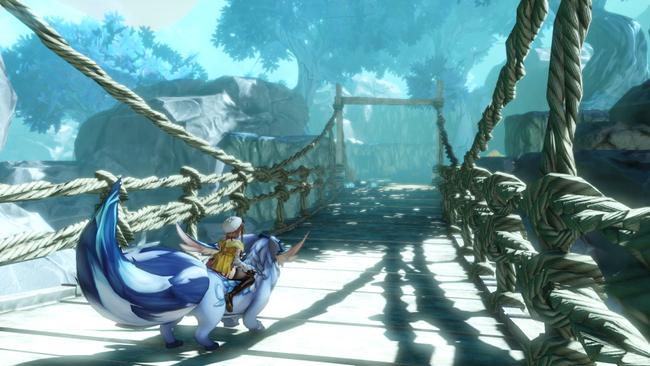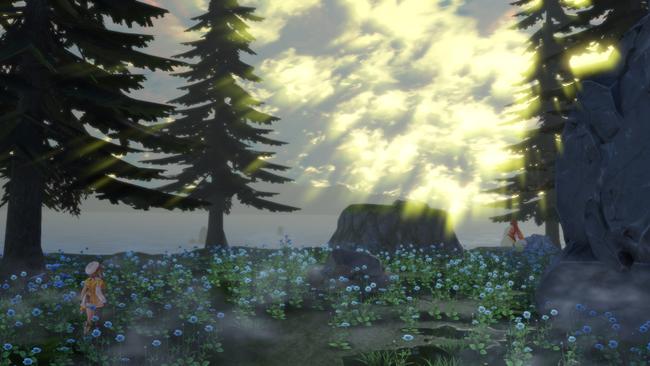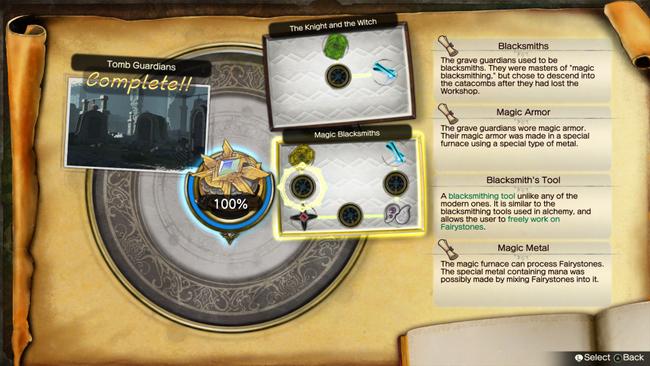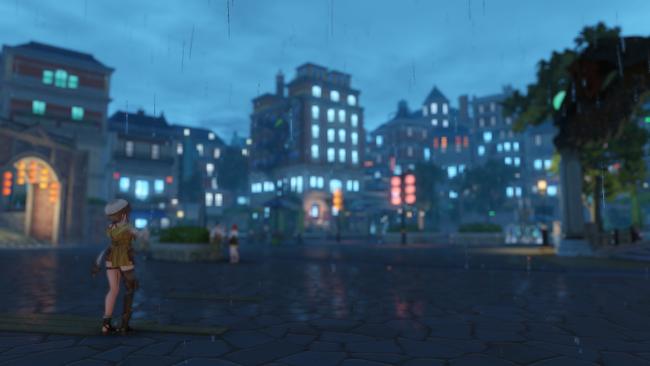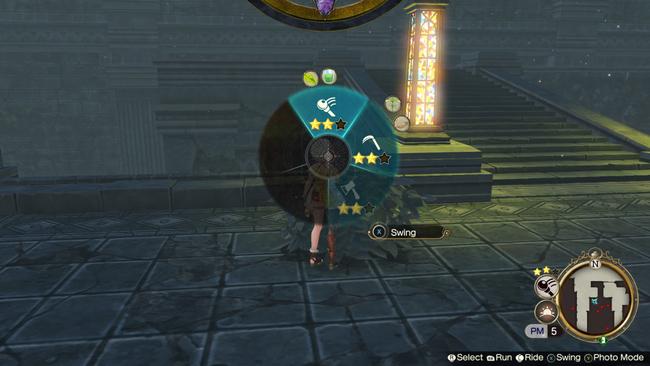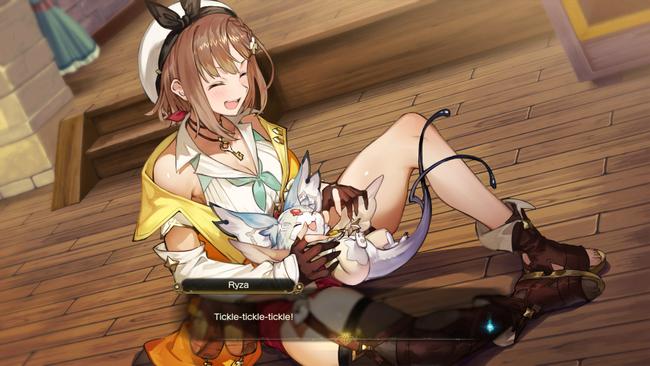
Atelier Ryza 2: Lost Legends and the Secret Fairy Review
I desperately hope that Atelier Ryza 3 can have a more traditional development cycle. That is a weird thing to headline a review with, but having finished Atelier Ryza 2: Lost Legends and the Secret Fairy , it maintains itself as the strongest takeaway I've had from the whole experience. It's not because Ryza 2 is a bad game, either - but rather, the opposite. Atelier Ryza 2 is so good within the confines of its development that I can't help but wonder what Gust could do if they could develop a game with more time in the oven.
Ryza 2’s variety of improvements is astonishing; that is to say, I don't know how they managed to develop Atelier Ryza 2 merely a year after Ryza's first adventure, let alone during 2020 of all years. I expected that I'd probably end up enjoying Ryza 2 going in, simply based on my feelings of the first game, but what I walked away with was something altogether greater than that. While Ryza 2 is by no means a perfect game, some of the changes and additions that have been made to the Atelier formula help make the game feel fresh, even compared to Ryza 1's already massive overhaul of many of the series' main mechanics.
I'm getting ahead of myself, though - let's start at the beginning.
Atelier Ryza 2, naturally, is a sequel to late 2019's Atelier Ryza: Ever Darkness and the Secret Hideout . As the first numbered sequel to the series in well over a decade, fans have undoubtedly been left wondering what the game would have to offer that a sequel with a different protagonist wouldn't be able to offer as well. After finishing Ryza 2 for myself, I can only agree that the decision Gust made was the right one. Ryza 1 was already a more story-heavy entry in the Atelier franchise, but much of that narrative was confined to the latter portions of the game's runtime. As much as I enjoyed what was present, I couldn't help but wish for more. Atelier doesn't necessarily need a story focus, but if you're going to go that route, I'd rather they went all in. At any rate, Ryza 1 clearly left room for Ryza's character to continue to grow.
In Ryza 2, players take control of an already competent alchemist, with a certain degree of renown to her name. Instead of synthesizing within a "secret hideout" in the middle of the woods, Ryza practices her alchemy in the middle of the capital city of Ashra-am Baird. This time, her journey doesn't spring forth from a simple desire to see the world; rather, she's tasked with both helping Tao on his mission to investigate ancient ruins that might have a connection to the history of alchemy, as well as to look into a mysterious "stone" entrusted to her by the village elder.
By all means, it's still a simple story to contend with, but the whole reasoning for her journey is less a childish desire to explore, and rather a more professional desire to do research. Throughout the story, and in many more slice-of-life scenes, we learn that in the 3 years following Ryza 1's ending, she's become a teacher - helping spread the knowledge and ethics of alchemy to the kids on Kurken Island. That same maturity spreads to the rest of the characters, and the narrative as a whole. It helps make Ryza 1's story feel a little more substantial than it initially was, and goes a good way towards making you care about the characters you meet, and what their goals are.
"Substance" really is the word that springs to mind the most when I think about Ryza 2, really. While you learn early on that the "stone" Ryza had been entrusted with is actually an egg holding the game's titular Fairy, Fi - what happens after that becomes a lot more interesting. The actual act of exploration is probably the aspect of the game that has seen the most overhaul from Ryza 1, with the addition of not just underwater exploration, but proper dungeons - with their own unique gimmicks and locales.
Very shortly into the narrative, Ryza will gain access to a compass that - upon clearing certain actions in each Ruin - will dot the map with various "fragments" comprising memories of the people that had lived there. These aren't just throwaway bits of information, either; they're all legitimate aspects of the culture and history of these civilizations, tying into what you find in each ruin, and giving you a real backstory to Ryza's world and lore. More than that, it helps fully realize the concept of Ryza truly researching these ruins, by putting you in the shoes of literally putting the information together in a way that helps explain these aspects of the numerous ancient societies.
Let me explain - each ruin will have five different topics for players to research, with the goal of trying to uncover the history and information surrounding a subject. Each of these topics can be separated into multiple sub-topics, and within those sub-topics, you'll have openings for you to place any of the information you've gathered from Fragments, in order to try and piece together the larger picture. There are hints to which piece of information fits in where, and it'll lock into place when you slot the right information, but ultimately piecing things together is the player's job. Who were these people? What was their purpose - what did they leave behind?
You don't have to go through the effort to fill everything out (though you should!), but you are required to fill out the information for at least one of the 5 topics in order to progress in each Ruin. Completing the topic with a gold border surrounding its image will reward you with a new synthesis recipe that will be required to progress further into the ruin. What's especially neat is how these recipes will continue to have a notable impact on the Ruins as a whole. The first recipe you're tasked with is to repair a bell clapper - once you set it, all of the bells within the dungeon will not only begin to ring out in the background, but new enemies will spawn across the map, in addition to opening the path forward.
Each Ruin has a moment like this, to varying degrees. Some are more notable than others, but the concept of directly influencing each of these ruins stays the same, and it leads to some incredibly cool moments when you see just how much these dungeons can be impacted by your alchemy. Combined with the improved graphical performance and the larger scope for many of the game's areas, it's hard not to be floored by just how much Gust's technical chops have improved. There were many moments in Ryza 2 where, frankly, I was blown away that Gust managed such an increase in the scope of their environments within their time budget. Ruins are the most obvious example of this, for sure, but I want to bring special attention to the fantastic new real-time reflections Gust have implemented into the game, as well.
When Gust marketed Ryza 2 on the addition of rain, and how character models would react to being wet - I didn't think much of it, rather then it was a neat little addition that I expected to start and end there. Instead, it's a vital component with how Gust utilizes its new-found love of real-time reflections. Every surface that can reflect something, will; and to varying degrees, depending on the property of the objects in question. Ashra-Am Baird at night is breath-taking - doubly so whenever it's raining, or just afterward. The reflection of the cityscape and the various NPCs rushing around would be impressive, even for a studio twice Gust's size, and it only gets better when the world is dotted with puddles that reflect everything accurately.
It's not just the presentation that's seen improvement. Exploration, which Ryza already expanded upon, has also seen some tweaks and additions. The most obvious of which is the addition of swimming; players are able to hop into bodies of water from the get-go, and eventually gain the ability to dive underwater to both explore hidden areas and to gather new types of synthesis materials. Players also gain access to the ability to swing across gaps, ride a monster (expediting travel and granting access to spots where you can mine for materials), and eventually access to a lamp which will help them light up dark environments. Combined with the increased scope of it all, it really solidifies these environments as actual areas that you're exploring.Reduced boundaries, combined with the improved visuals, helps sell the immersion of it all.
Of course, exploration is only a small portion of the Atelier formula - finding and gathering materials to synthesize items is still a significant part of the gameplay loop, as it always has been. Ryza 1 had the ability for players to use multiple gathering tools to determine what sorts of materials that you could gather from the various types of nodes on any given map. It was great for variety’s sake, and it made gathering materials all the more dynamic. However, the number of tools you ended up having to carry around got a little out of hand, and definitely could have used some trimming. Thankfully, Ryza 2 delivers. Instead of forcing players to eventually combine different Gathering Tools together, progression is instead handled by upgrading your existing Gathering Tools into new variants; you'll always have exactly the right number of gathering tool slots to accommodate your full arsenal, with none of the inventory management involved from Ryza 1. Tools that you use to gather and tools that you use for exploration have also been given separate classifications, though the end result - being able to equip every tool at once - remains the same.
By far the largest quality of life feature added to gathering is the addition of thought bubbles that will pop up whenever Ryza is within gathering distance of a node. You'll see a preview of the items that you can gather from any specific point, and going into the new gathering tool window will list the icons of said materials along the outer rim of the circle, corresponding to the tool they can be gathered from. It's an insanely cool change, and one that seems obvious in hindsight.There's no more guesswork about which gathering node will give you which material. If I were to list the best change Ryza 2 brings to the formula, this would unironically be it.
Synthesis itself has seen fewer changes. The most notable of which will undoubtedly be the most controversial. Instead of Quality being an average of the Quality of each individual material added to a synthesis, Quality is now closer to a cumulative total. In other words, Quality will never drop when you place a new material into a recipe, it will only increase. If you've never played Atelier, this probably doesn't sound like a major change; but if you have, you can probably already tell just how fundamental this change ultimately ends up being. I foresee this being a controversial change, to say the least. Ryza 1 was a little ridiculous with the grind necessary for making strong items and gear, which this solves, but I'm still ultimately mixed with the change.
By the end of the game, and once you've unlocked all of the power gates within the skill tree (more on that later), it becomes trivial to synthesize Quality 999 equipment. Needless to say, that does take a lot of the edge out of synthesis - though I would argue that Quality was always needless grinding in the first place and dealing with the skills & traits for equipment was always more important. Nonetheless, the result is that the skill floor for crafting items is now easier - along with the skill ceiling. There's still depth and min-maxing, but it's inherently casualized from the previous incarnation. New features like essences that can either change the elemental attributes of applicable material loops or, when used with a loop of the same element boost the highest potential effect of the loop in question, still gives players more to consider. Outside of synthesis, Evolution Link gives players more utility by allowing you to merge two Use items, granting one Use item one of the effects of the other; sometimes even combining them into a new item entirely.
Most of the base synthesis recipes are now unlocked through a new Skill Point, or SP, system. You gain SP through completing requests at Zephine's Cafe, synthesizing items, or as bonuses for completing non-essential subjects in ruins. These can be spent towards buffs to your gathering skills, upgrades to your max synthesizable Quality for items, new synthesis recipes, and even features like Item Duplication and Gem Reduction (alongside some of the previously mentioned new features like Essences and Evolution Link) depending upon how far into the story you've progressed. Eventually, you'll even gain access to different types of Core Drive abilities.
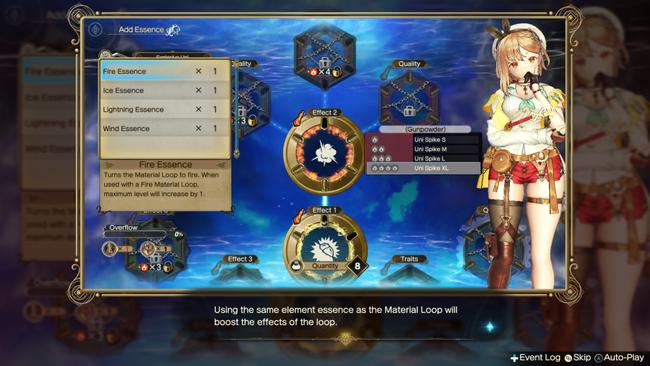
Use items felt like more of an afterthought in Ryza 1, all things considered. Sure, you could put your all into a use item and not have to worry about losing it after you actually used it in battle, but the Core Charge system meant that you were always limited on how often you could actively use items that you had synthesized. The end result was a battle system that seemed to de-emphasize one of the core aspects of previous Atelier combat systems - using your OP crafted items to decimate enemies. Ryza 1's battle system was great, but it didn't necessarily feel like "Atelier" with those restrictions in place. Ryza 2 fixes things up in a few smart ways, with the main change being a complete overhaul of the Core Charge system.
It's kind of impossible to talk about this change without bringing up the rest of the battle system as a whole, which is already a massive improvement from the way that items were integrated into battles in Ryza 1. Instead of having a pool of Core Charges that you utilize, and will inevitably have to recharge at a flower like in Ryza 1, players now start every battle with a "default" number of CC allotted to a character. This starts out at zero, but the more that you utilize items in battle, you'll gain currency that can be used to upgrade each party member's core crystal. This includes components such as a character's minimum and maximum CC charges, the level of their elemental affinity for each of the game's 4 elements (with players able to equip up to 2 at a time), and a new "Core Drive" ability, which acts much like a Fatal Drive from Ryza 1, but with items.
Core Drives are activated whenever you use a combination of items corresponding to the Core Drive that you have equipped to a character. These will activate after the items in question are utilized at the same time, and apply another effect on top of whatever ones the items already had. If you use a Core Drive that activates after you use 3 different types of bombs at the same time - you'll be gifted a veritable explosion of elemental damage on the battlefield. Other core drives can offer different types of damage, buffs, and more. All of them are very powerful, and each character can both only have one equipped at any time, and can only activate theirs once per battle. This works in tandem with the rest of the battle system in a very clear and concise way - much as I said that battles start out with a "minimum" CC charge for each character, CC itself will now rise whenever you land skills or orders in battle. These charges will stock up incredibly quickly in the late game, too, as Ryza 2 doubles down on the action-focused ATB combat from the first game.
The main changes to the regular battle system, outside of the complete CC overhaul, is as follows: in Ryza 1, the name of the game was to use standard attacks to raise Action Points (AP) and then to expend them to either increase your tactics level (which raises the maximum amount of AP that you can hold), or to utilize it to use skills. In Ryza 2, Tactics Levels now rise the more skills and orders you fire out, and there is damage-scaling the more skills you can manage to chain into a combo. Furthermore, you will eventually unlock the ability to swap out the character you're attacking with to a designated "support" character during the middle of a combo to continue a chain even further than before. Beyond that, you can now block enemy attacks - and if done so with the right timing - not only will the character receive much less damage, but they'll even gain AP for their troubles.
It's a lot to take in, but in practice - along with the changes to Core Charges - we're left with a battle system that is much faster-paced and frenetic compared to the first game. Everything else, like Orders and Fatal Drives, remain much the same. It's a fantastic change of pace, and while those that might have been turned away from the shift to action-based combat will probably still dislike the battle system - it's undoubtedly an improvement to the first game’s in basically every way. Which sums up Ryza 2 as a whole, really.
It's mind-boggling just how much Gust managed to squeeze into Ryza 2 with such a short time budget; the increased scope, both in terms of gameplay mechanics as well as the presentation, is nothing to scoff at. While not all of the changes will necessarily gel with every Atelier player, they clearly build upon the goals that Gust had set for themselves with the first game. It ultimately makes Ryza 2 feel much more like a traditional JRPG than the first game did, which is sure to appeal to more players - and I don't necessarily think that comes at the expense of what made the Atelier series so unique in the first place. There are moments where you can clearly see the limitations of the game's development shine through - such as with recycled assets - but even then, most of the time Gust manages to contextualize things so that you never really feel like the game was made in such a short timeframe.
It's exactly that feeling that makes me pine for the inevitable Ryza 3 to get a "regular" development schedule; if Ryza 2 shows us what Gust can deliver in a year, especially under the restrictions that a pandemic would bring, I can only wonder what they might be able to do with a larger time and budget. For as much as Ryza 2 delivers with its lore and story, there's just enough under the surface pointing towards the potential for something greater. Gust have more than proven themselves, and I can only hope we can see them at their full potential. Ryza 2 makes the case for letting Ryza 3 have a longer development time, but more than that - it shows us a glimpse of the true potential Gust have yet to unravel.
